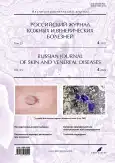Widespread dermatophytosis after combined immunosuppressive therapy in a patient with COVID-19
- Authors: Kochergin N.G.1, Maximov I.S.1, Dodina M.I.1, Shitko O.A.1, Petukhova E.V.1
-
Affiliations:
- I.M. Sechenov First Moscow State Medical University (Sechenov University)
- Issue: Vol 25, No 4 (2022)
- Pages: 313-321
- Section: DERMATOLOGY
- URL: https://journals.rcsi.science/1560-9588/article/view/109974
- DOI: https://doi.org/10.17816/dv109974
- ID: 109974
Cite item
Abstract
Mycotic diseases of human skin are frequently diagnosed reaching 20–25% of the population prevalence. The leading factor in the mycotic prevalence is the high survival rate of fungi in various environmental conditions. Up to 30 genera of fungi constantly live on human skin and mucous membranes. This constant balance of their presence on the body and interaction with it is called a mycobiome. If the balance between it and the macroorganism is disturbed, the reproduction of fungi begins and mycotic skin lesions develop.
The study included the patient V. 75 years old, who came in with complaints of widespread rashes on the skin of the body and limbs accompanied by peeling after a COVID-19 infection. Microscopy revealed mycelium of pathogenic fungi. The patient received systemic and topical antifungal therapy until the end of hospitalization. He continued to receive terbinafine on an outpatient basis in combination with a topical antimycotic after discharge. Short review on baricitinib and levilimab is presented. According to the results of the study, a 60–70% regression of the skin process was achieved after 2 weeks at discharge. One month later a complete regression of the skin process was achieved due to the therapy.
The use of the combination of janus-kinase inhibitors with biological drugs and systemic glucocorticosteroids in COVID-19 patients has a powerful immunosuppressive effect on the body. It leads to the development of a common fungal skin lesion, which was observed in our patient.
Full Text
##article.viewOnOriginalSite##About the authors
Nikolay G. Kochergin
I.M. Sechenov First Moscow State Medical University (Sechenov University)
Author for correspondence.
Email: nkocha@yandex.ru
ORCID iD: 0000-0001-7136-4053
SPIN-code: 1403-3031
MD, Dr. Sci. (Med.), Professor
Russian Federation, MoscowIvan S. Maximov
I.M. Sechenov First Moscow State Medical University (Sechenov University)
Email: maximov.is@mail.ru
ORCID iD: 0000-0003-2850-2910
SPIN-code: 1540-1485
Assistant Lecturer
Russian Federation, MoscowMaria I. Dodina
I.M. Sechenov First Moscow State Medical University (Sechenov University)
Email: midd@list.ru
ORCID iD: 0000-0003-3759-8942
SPIN-code: 5069-9431
MD, Cand. Sci. (Med.)
Russian Federation, MoscowOlga A. Shitko
I.M. Sechenov First Moscow State Medical University (Sechenov University)
Email: styvrinaolya1@gmail.com
ORCID iD: 0000-0003-2562-8884
SPIN-code: 9677-1978
Russian Federation, Moscow
Eugenia V. Petukhova
I.M. Sechenov First Moscow State Medical University (Sechenov University)
Email: petuxova0304@gmail.com
ORCID iD: 0000-0002-9396-4874
Student
Russian Federation, MoscowReferences
- Stebbing J, Nievas SG, Falcone M, et al. JAK inhibition reduces SARS-CoV-2 liver infectivity and modulates inflammatory responses to reduce morbidity and mortality. Sci Adv. 2021;7(1):eabe4724. doi: 10.1126/sciadv.abe4724
- Hoang TN, Pino M, Boddapati AK, et al. Baricitinib treatment resolves lower-airway macrophage inflammation and neutrophil recruitment in SARS-CoV-2-infected rhesus macaques. Cell. 2021;184(2):460–475.e21. doi: 10.1016/j.cell.2020.11.007
- Basile K, Halliday C, Kok J, Chen SC. Fungal infections other than invasive aspergillosis in COVID-19 patients. J Fungi (Basel). 2022;8(1):58. doi: 10.3390/jof8010058
- Casalini G, Giacomelli A, Ridolfo A, et al. Invasive fungal infections complicating COVID-19: a narrative review. J Fungi (Basel). 2021;7(11):921. doi: 10.3390/jof7110921
- Huang F, Luo ZC. Risk of adverse drug events observed with baricitinib 2 mg versus baricitinib 4 mg once daily for the treatment of rheumatoid arthritis: a systematic review and meta-analysis of randomized controlled trials. BioDrugs. 2018;32(5):415–423. doi: 10.1007/s40259-018-0304-3
- Abdoli A, Falahi S, Kenarkoohi A. COVID-19-associated opportunistic infections: a snapshot on the current reports. Clin Exp Med. 2022;22(3):327–346. doi: 10.1007/s10238-021-00751-7
- Ahmad A, Zaheer M, Balis FJ. Baricitinib. In: StatPearls. Treasure Island (FL): StatPearls Publishing; 2022. [Updated 2022 Jul 12]. Available from: https://www.ncbi.nlm.nih.gov/books/NBK572064/. Accessed: 15.08.2022.
- Reich K, Kabashima K, Peris K, et al. Efficacy and safety of baricitinib combined with topical corticosteroids for treatment of moderate to severe atopic dermatitis: a randomized clinical trial. JAMA Dermatol. 2020;156(12):1333–1343. doi: 10.1001/jamadermatol.2020.3260
- Kaplon H, Reichert JM. Antibodies to watch in 2021. MAbs. 2021;13(1):1860476. doi: 10.1080/19420862.2020.1860476
- Gorodin VN, Moisova DL, Zotov SV, et al. Proactive anti-inflammatory therapy with levilimab for patients with COVID-19. Infekc Bolezni. 2021;19(3):14–23. (In Russ). doi: 10.20953/1729-9225-2021-3-14-23
- Lomakin NV, Bakirov BA, Protsenko DN, et al. The efficacy and safety of levilimab in severely ill COVID-19 patients not requiring mechanical ventilation: results of a multicenter randomized double-blind placebo-controlled phase III CORONA clinical study. Inflamm Res. 2021;70(10-12):1233–1246. doi: 10.1007/s00011-021-01507-5
- Shcherbak SG, Anisenkova AY, Mosenko SV, et al. Basic predictive risk factors for cytokine storms in COVID-19 patients. Front Immunol. 2021;12:745515. doi: 10.3389/fimmu.2021.745515
- Ghosn L, Chaimani A, Evrenoglou T, et al. Interleukin-6 blocking agents for treating COVID-19: a living systematic review. Cochrane Database Syst Rev. 2021;3(3):CD013881. doi: 10.1002/14651858.CD013881
- Gorodin VN, Moisova DL, Zotov SV, et al. Proactive anti-inflammatory therapy with levilimab for patients with COVID-19. Infekc Bolezni. 2021;19(3):14–23. (In Russ).
Supplementary files










